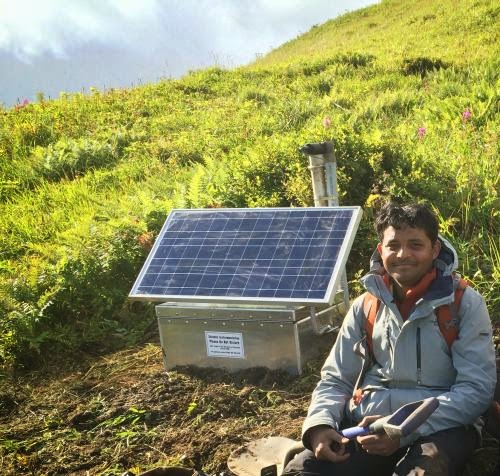
An earthquake expert at the University of California, Riverside is leading a team of seismologists and volcanologists to conduct an experiment in Alaska that will record a variety of seismic events in that state. The experiment will also help better describe the characteristics of the Alaska-Aleutian subduction zone, one of the most seismically active regions in the world that is also home to many active volcanoes.
“In spite of being a hot-spot of earthquake and volcanic hazard, this area is poorly studied because of its inaccessibility, remoteness and rugged terrain,” said Abhijit Ghosh, an assistant professor of geophysics in UC Riverside’s Department of Earth Sciences and the research project’s principal investigator.
Called the “Aleutian Array of Arrays,” the project began collaboratively between UCR, the University of Wisconsin-Madison, the Alaska Volcano Observatory and the U.S. Geological Survey. It was launched last year when the researchers set up 19 seismic stations within a 1 kilometer-square area on one of the Aleutian Islands. This seismic array of stations acts like a mini-radar that continuously scans for earthquakes and fault movements beneath the ground. Eventually, more arrays will be set up.
“The carefully designed array we started with is placed in a strategic location so that it can simultaneously image the subduction fault and the volcanic system,” Ghosh said. “Our experiment aims at studying the active Alaska-Aleutian subduction zone using multiple seismic arrays – an array of arrays – that will eventually span a larger area. This is the largest seismic experiment in this part of the Aleutian Islands. This is also the first time that the array of arrays approach is being used in this region.”
Ghosh explained that the Alaska-Aleutian subduction zone experiences frequent damaging earthquakes, a notable example being the magnitude 9.2 Good Friday earthquake in 1964. Ground shaking due to this earthquake and the resulting tsunami caused severe damage in the entire region, including Anchorage, Alaska’s capital.
Faults release stress in the form of earthquakes, which are caused by a sudden slip along faults. Recently, it has been discovered that faults also slip slowly. These so-called “slow earthquakes” occur over days and months, and release significant amount of stress.
Results from a 2012 pilot study done by Ghosh and his colleagues in Alaska showed that the Alaska-Aleutian subduction zone experiences high tremor activity, a signature of slow earthquakes.
“We identified low-frequency earthquakes, which are a specific type of earthquakes characterized by slow movement on the subduction fault,” said Ghosh, who presented the pilot study results in a meeting of the American Geophysical Union in 2013.
He explained that although California’s San Andreas Fault is characterized by a completely different tectonic setting (strike-slip as opposed to subduction), it shows tremor and low-frequency earthquake activity, which are signatures of slow earthquakes.
“We expect the Aleutian Array of Arrays experiment will shed new light on the details of slow earthquakes, physics of fault movement and associated seismic hazards,” Ghosh said. “There are lessons for California in this research.”
His team plans to go back to the Aleutian Islands this summer to install at least two more seismic arrays. These arrays, combined with the one installed this year, will work together to complete the array of arrays.
“They will simultaneously image the subduction megathrust and volcanic system with very high resolution,” Ghosh said.
Note : The above story is based on materials provided by University of California.










